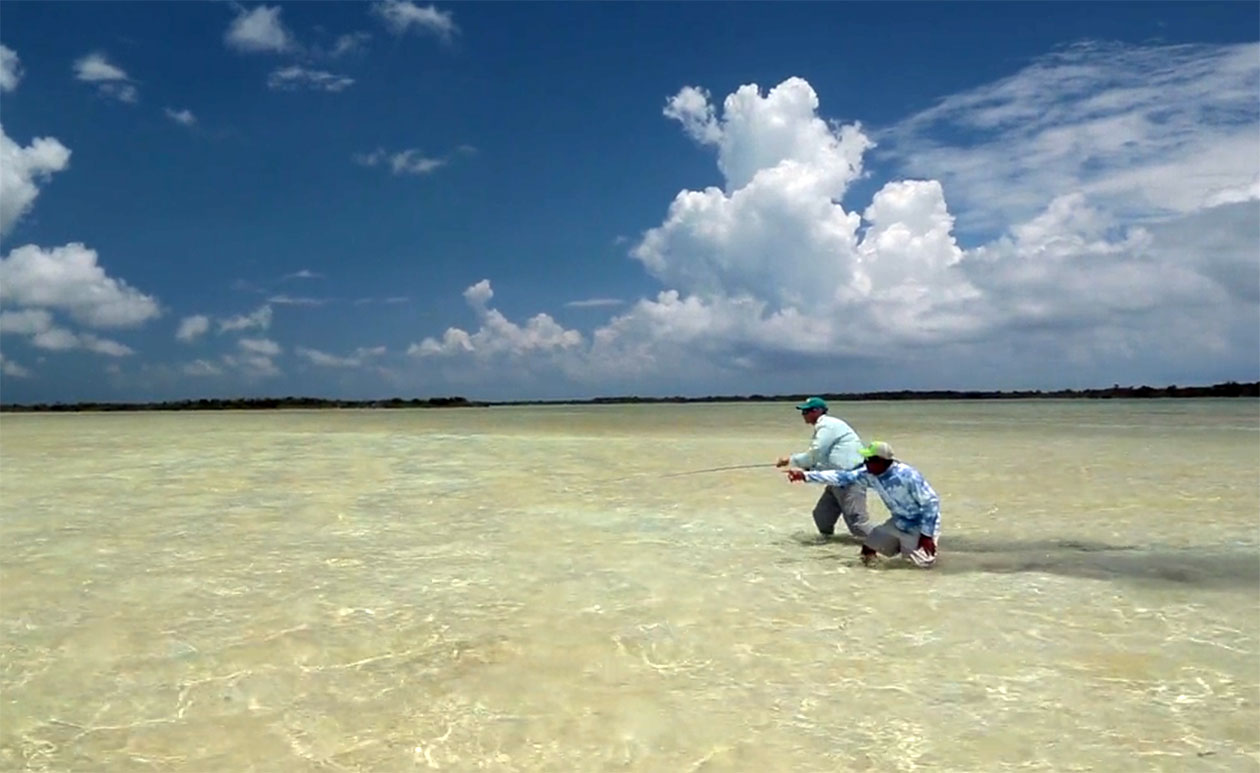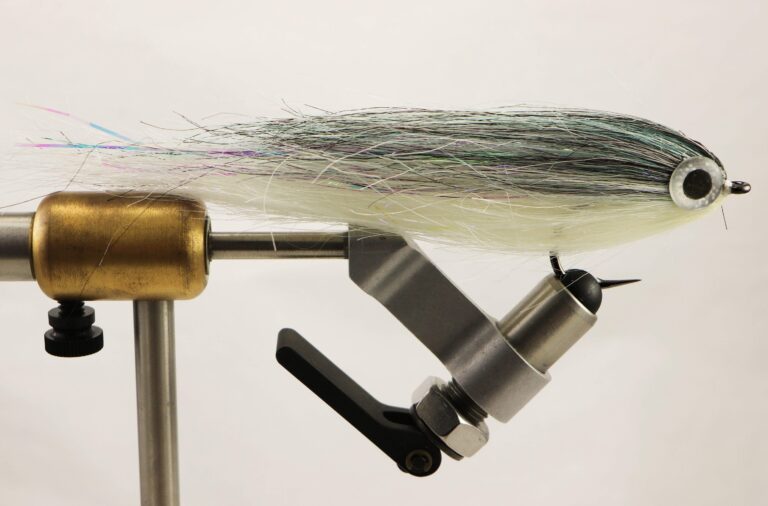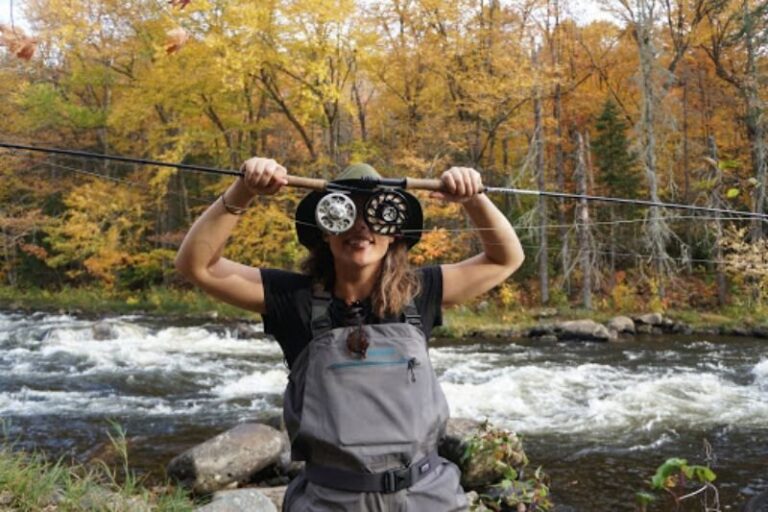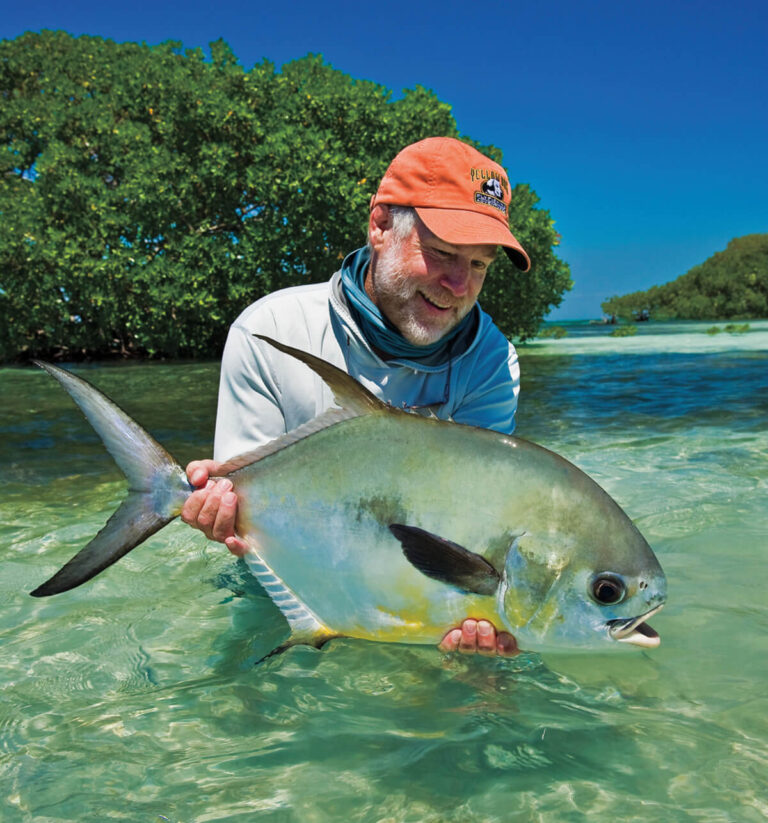Yes, you can do flats fishing in both saltwater and freshwater. Flats fishing can be enjoyed in both saltwater and freshwater environments, providing ample opportunities for anglers to target a variety of fish species.
The unique characteristic of flats, which are shallow areas with clear water, makes it an ideal fishing spot as it allows anglers to sight fish and target species such as bonefish, tarpon, redfish, and trout, among others. Whether you prefer the excitement of saltwater flats or the tranquility of freshwater flats, flats fishing offers thrilling angling experiences in both environments.
So, grab your fishing gear and get ready to explore the flats in saltwater or freshwater for an unforgettable fishing adventure.

Credit: midcurrent.com
Understanding The Basics Of Flats Fishing
Definition Of Flats Fishing
Flats fishing refers to a specific angling technique that involves fishing in shallow, calm waters known as “flats. ” These flats are typically found in both saltwater and freshwater environments and hold an abundance of fish species. Here are some key points to understand about flats fishing:
- Flats fishing primarily involves targeting fish species that inhabit the shallows, such as bonefish, permit, redfish, and tarpon.
- Anglers wade through the flats or use specialized shallow-draft boats to navigate these shallow waters.
- This fishing technique requires stealth, as fish in the flats are often wary and easily spooked by noise or disturbances.
- Flats are usually located near shorelines, estuaries, mangroves, or coral reefs, providing a diverse and vibrant ecosystem for various fish species.
- Flats fishing offers a unique challenge to anglers, as they need to accurately cast their bait or lure, and carefully present it to the fish in order to entice a strike.
Key Characteristics Of Flats Environments
To better understand flats fishing, it’s important to recognize the key characteristics of flats environments. These characteristics play a significant role in determining the behavior and movement of fish in the flats. Here are some important aspects to consider:
- Depth: Flats are characterized by shallow water depths, typically ranging from only a few inches to a couple of feet. The depth of the flats can vary depending on tides, seasons, and geographical locations.
- Structure: Flats may feature various structures such as seagrass beds, sandbars, oyster beds, coral patches, or submerged rocks. These structures provide habitat for marine life and offer hiding places for fish.
- Vegetation: Flats often have extensive vegetation, such as seagrasses, mangroves, or marsh grass. These plant communities support the flats ecosystem by providing food, shelter, and oxygen.
- Water clarity: The water in flats is generally clear and transparent. This clarity allows anglers to spot fish and make accurate casts, enhancing the excitement and challenge of flats fishing.
- Tidal influence: Tides play a crucial role in the flats environment. As the tide rises and falls, it affects the movement and behavior of fish, influencing feeding patterns and creating strategic angling opportunities.
Benefits Of Flats Fishing In Both Saltwater And Freshwater
Flats fishing offers numerous benefits for anglers, regardless of whether they are fishing in saltwater or freshwater. Here are some advantages of flats fishing in both environments:
- Diversity: Flats fishing provides an opportunity to encounter various fish species in one location. In saltwater flats, you can target species like bonefish, permit, and tarpon. In freshwater flats, you might encounter bass, pike, trout, or even carp.
- Exhilarating challenges: Fishing in the flats requires skill, precision, and patience. The stealthy approach, accurate casting, and delicate presentation of bait or lures make flats fishing a thrilling and rewarding experience for anglers.
- Visual excitement: The clear and shallow waters of flats environments enable anglers to visually spot fish, sometimes referred to as “sight fishing.” Spotting a fish and making a successful cast adds an element of excitement and engagement to the fishing experience.
- Conservation-minded: Flats fishing promotes catch-and-release practices, contributing to the conservation of fish populations and the sustainability of the ecosystem. Practicing proper handling techniques ensures the fish’s survival, allowing future generations of anglers to enjoy the thrill of flats fishing.
- Connection with nature: Fishing in the flats offers a unique opportunity to immerse oneself in the beauty of nature. From the stunning landscapes to the abundance of wildlife, flats fishing allows anglers to connect with their surroundings in a profound way.
Flats fishing provides an extraordinary angling experience, combining the thrill of the hunt with the serenity of the natural world. Whether you venture into saltwater flats or explore freshwater flats, the diverse fish species, the challenging techniques, and the connection with nature make flats fishing an adventure worth pursuing.
Flats Fishing In Saltwater
Exploring Saltwater Flats And Their Uniqueness
The world of saltwater flats fishing is an exciting and unique experience. These shallow coastal areas are teeming with life, offering anglers a chance to target a wide variety of species. Here are some key points to explore when it comes to saltwater flats:
- Flats are shallow areas of coastal waters that are less than three feet deep. They are typically sandy or grassy and provide important habitats for many species of fish and other marine life.
- The unique feature of saltwater flats is their ability to attract a diverse range of fish that seek shelter, food, and breeding grounds. The rich ecosystem of flats supports a food chain that sustains a healthy population of target species.
- Flats can be found all around the world, from the crystal-clear waters of the caribbean to the vast expanse of the florida keys. Each location has its own distinct characteristics and offers different fishing opportunities.
Popular Saltwater Flats Fishing Locations Around The World
Saltwater flats fishing is a popular sport enjoyed by anglers worldwide. Here are some renowned locations for flats fishing:
- The florida keys: Known as the “sport fishing capital of the world,” the flats of the florida keys attract anglers from all over. From key west to islamorada, these flats offer opportunities to catch bonefish, tarpon, and permit.
- Belize: This central american paradise is home to extensive flats along its coastlines and cayes. It’s a prime destination for pursuing bonefish, as well as permit and tarpon.
- The bahamas: With over 700 islands and cays, the bahamas are a flats fishing haven. The expansive flats around andros island and the abacos are famous for their bonefish population.
- Christmas island: Located in the pacific ocean, this remote atoll is a dream destination for saltwater flats enthusiasts. Anglers can target bonefish and giant trevally in the flats surrounding the island.
Target Species For Saltwater Flats Fishing
Saltwater flats are home to various species that anglers specifically target. Here are some of the most sought-after species in flats fishing:
- Bonefish: Known for their strength and elusive nature, bonefish are one of the primary targets for flats anglers. They are highly prized for their speed and acrobatics.
- Tarpon: These silver giants are famous for their aerial displays when hooked. Found in saltwater flats, tarpon can reach impressive sizes and offer an exhilarating fight.
- Permit: Permit are notoriously challenging to catch due to their wariness and finicky eating habits. Anglers consider catching permit a true trophy and a testament to their skills.
- Redfish: Commonly found in the shallow flats of the gulf coast, redfish provide exciting opportunities for anglers. They are known for their powerful runs and hard-hitting strikes.
Techniques And Gear Required For Successful Saltwater Flats Fishing
Achieving success in saltwater flats fishing requires employing the right techniques and gear. Here are some essentials for a successful flats fishing adventure:
- Sight fishing: Flats fishing often involves sight casting, where anglers spot fish in the clear shallow waters and target them directly. Developing good fish-spotting skills is crucial for success.
- Fly fishing: Fly fishing is a popular technique used in flats fishing due to its ability to present lightweight flies delicately. Many anglers find that bonefish and permit are more receptive to fly presentations.
- Spinning tackle: Anglers also use spinning tackle, equipped with lightweight rods and reels, to target flats species. This versatile setup allows for casting different types of lures and baits effectively.
- Polarized sunglasses: A good pair of polarized sunglasses is essential for spotting fish and reducing glare on the water’s surface. They enhance visibility and allow anglers to see the fish clearly.
- Flies and lures: Flies such as shrimp patterns, crab imitations, and baitfish imitations are popular choices for flats fishing. Various lures like soft plastics, spoons, and topwater plugs are effective when targeting species like redfish and tarpon.
Remember, the success of your flats fishing expedition depends on understanding the unique characteristics of saltwater flats, the target species, and utilizing the appropriate techniques and gear. Get ready to embark on an unforgettable angling adventure in the mesmerizing world of saltwater flats!
Flats Fishing In Freshwater
Flats fishing is often associated with saltwater environments and the vast expanse of ocean. However, flats fishing can also be enjoyed in freshwater settings, providing anglers with a unique and exciting experience. Freshwater flats are areas of shallow water, typically found in lakes, rivers, and even certain reservoirs.
These flats form the perfect habitat for various species of fish and offer a different kind of challenge for anglers. Let’s explore the world of freshwater flats fishing.
Different Types Of Freshwater Flats And Their Ecosystems:
- Weed beds and grass flats: These flats are dense with aquatic vegetation like lilies, submerged weeds, and grass. They provide excellent cover and food sources for fish.
- Sand flats: Some freshwater bodies have sandy flats that resemble those found in saltwater environments. These flats are usually devoid of vegetation but are home to species that prefer open areas with minimal structure.
- Limestone flats: Found in areas with limestone bedrock, these flats create unique habitats with crevices and caves where fish can seek shelter.
- Oyster flats: Some freshwater systems may have oyster flats, similar to those found in coastal regions, creating a diverse and productive ecosystem.
Notable Freshwater Flats Fishing Destinations:
- Everglades national park, florida: This vast and iconic national park is famous for its expansive freshwater flats and diverse fish species such as snook, tarpon, redfish, and largemouth bass.
- Lake fork, texas: Known as the trophy bass capital of texas, lake fork features productive flats that provide excellent opportunities to catch largemouth bass.
- Louisiana marshes: These vast wetlands are home to an abundance of flats and are known for their redfish and speckled trout fisheries.
- Amazon rainforest, brazil: The amazon basin boasts extensive flats where anglers can target peacock bass, arapaima, and a myriad of other exotic species.
Target Species For Freshwater Flats Fishing:
- Largemouth bass: Known for their size and aggressive behavior, largemouth bass are a popular quarry in freshwater flats.
- Redfish: These strong and powerful fish are common in coastal and brackish water flats, providing anglers with thrilling battles.
- Snook: Found in mangroves and grass flats, snook are prized for their acrobatic fights and challenging nature.
- Peacock bass: Native to south america, these visually stunning fish thrive in amazonian flats and offer a formidable challenge for anglers.
Techniques And Gear Specific To Freshwater Flats Fishing:
- Fly fishing: Fly fishing is a popular technique for targeting fish in flats. It allows anglers to present small and lifelike flies to mimic natural prey.
- Light tackle spinning gear: Many anglers prefer using light spinning rods with braided line and fluorocarbon leaders for finesse presentations and increased sensitivity.
- Topwater lures: Fishing with topwater lures can be highly effective in freshwater flats, enticing aggressive strikes from predatory fish like bass and snook.
- Flats boats or kayaks: Maneuverability is crucial in flats fishing. Specialized flats boats or kayaks with shallow drafts are commonly used to access and navigate these shallow waters.
So, if you thought flats fishing was limited to saltwater destinations, think again! Freshwater flats offer their own unique challenges and opportunities for anglers to explore. Whether you’re targeting largemouth bass in a weed bed or peacock bass in the amazon, freshwater flats fishing is an exciting and rewarding pursuit.
Benefits Of Flats Fishing In Both Saltwater And Freshwater
When it comes to fishing, flats fishing in both saltwater and freshwater environments offers a unique and exciting experience. Whether you prefer the thrill of hooking a saltwater species or the tranquility of freshwater fishing, flats fishing provides a versatile and rewarding angling opportunity.
Let’s explore the benefits of flats fishing in both saltwater and freshwater environments.
Versatility And Variety Of Fishing Opportunities
- Flats fishing in saltwater and freshwater provides a wide range of fishing opportunities, catering to different preferences and skill levels.
- In saltwater flats, you can target species like bonefish, tarpon, redfish, and permit, which are known for their strength and acrobatic fights.
- Freshwater flats offer abundant opportunities to catch species such as trout, bass, pike, and carp, each possessing its own unique characteristics.
- Whether you enjoy fly fishing, spin casting, or bait fishing, flats fishing allows you to utilize various techniques and methods to pursue your desired catch.
Opportunities For Sight Fishing And Stalking Fish
- One of the most thrilling aspects of flats fishing is the opportunity for sight fishing, where you can visually spot fish and cast your bait or lure directly to them.
- In saltwater flats, the crystal-clear waters allow you to spot fish like bonefish and permit cruising the shallow areas, testing your angling skills and accuracy.
- Freshwater flats present similar opportunities, providing a chance to sight fish species like trout or bass as they move stealthily in the clear waters, making for an exhilarating and immersive fishing experience.
- Stalking fish in the flats requires patience, strategy, and quick reflexes, creating a challenging and rewarding angling adventure that is bound to keep you engaged.
Conservation And Sustainability Considerations For Flats Fishing
- Flats fishing, when practiced responsibly, can contribute to conservation efforts and promote sustainable fishing practices.
- Catch-and-release policies are widely encouraged in flats fishing, ensuring the survival and well-being of the targeted fish species.
- By releasing fish back into their natural habitat, you contribute to the preservation of their populations, allowing future generations to enjoy the sport.
- Being mindful of catch limits, following local regulations, and practicing ethical angling practices help maintain the ecological balance of flats ecosystems.
- Sustainable fishing practices not only benefit marine and freshwater environments but also support the local economy by attracting anglers from all over the world.
Flats fishing in both saltwater and freshwater environments provides a range of benefits, from offering versatile fishing opportunities to the thrill of sight fishing and contributing to conservation efforts. Whether you are a seasoned angler or a beginner, exploring the flats is a rewarding way to experience the beauty and excitement of the fishing world.
So grab your rod and tackle, and get ready to embark on a flats fishing adventure that promises unforgettable memories.
Conclusion
If you’re an angler seeking diverse fishing opportunities, both saltwater and freshwater flats can provide exciting ventures. Whether you prefer the challenge of hooking a trophy-sized bonefish on a tropical saltwater flat or the tranquility of chasing freshwater species like bass and trout in shallow water, flats fishing offers something for everyone.
With the right gear and knowledge, you can successfully fish in both environments. Remember to research the specific regulations and seasons for each area you plan to fish, as well as consult local guides who can provide invaluable expertise. By understanding the unique characteristics of saltwater and freshwater flats, you can maximize your chances of success and create unforgettable fishing memories.
So, grab your rod, pack your essentials, and get ready to explore the diverse and thrilling world of flats fishing. Happy angling!




